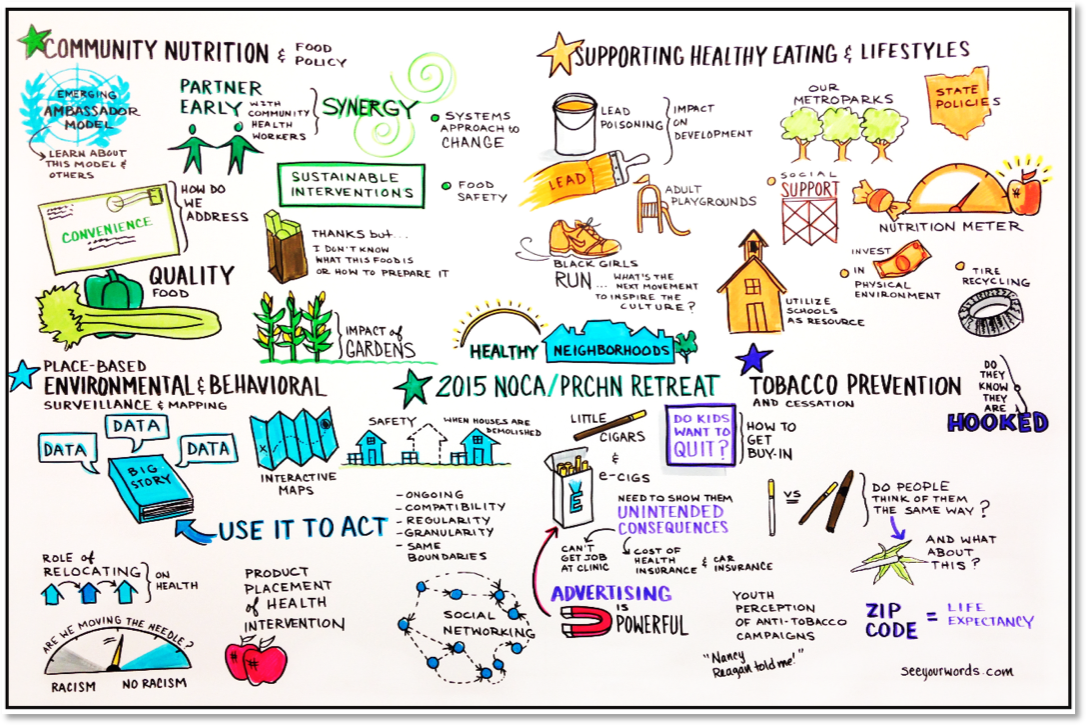Hello! I’m Clara Pelfrey, Translational Research Evaluation TIG past chair and evaluator for the Clinical and Translation Science Collaborative at Case Western Reserve University. I’m joined by graphic recorder Johnine Byrne, owner of See Your Words, and Darcy Freedman, Associate Director of the Prevention Research Center for Healthy Neighborhoods (PRCHN). We’d like to extend our previous AEA365 post on graphic recording and show how it can be used to create a shared vision between researchers doing community engaged research and community members.
Graphic recording (GR) is a visual capturing of people’s ideas and expressions. The GR shown below was created at an annual retreat of the PRCHN’s community advisors. It visually captured the community’s ideas around the major areas of work done by the center, helping to identify priority areas for future work and opportunities for collaboration. The PRCHN used the GR to show what role its partners play, the questions they have, what the bottlenecks are and any risks or unintended consequences to attend to.

Hot Tip:
Evaluation uses of graphic recording (GR) in community based research/community engagement:
- Provide qualitative analysis themes. GR acts as a visual focus group report, providing opportunities to interact with your study findings.
- GR can show system complexity. A non-profit organization working on youth justice commissioned a systems model GR so that all the service providers for youth experiencing homelessness could: 1) see where they fit into the wider system; 2) identify gaps and redundancies; 3) identify feedback loops; 4) find reinforcements.
- Focus group participants may be reluctant to speak up in a group. Seeing images on the GR encourages participants to speak.
- GR allows everyone to share their ideas in real-time. This immediacy creates energy and fosters more discussion.
- Get right to the heart of the matter. Concepts on the GR become objects and lose their attribution to a person, fostering conversation that is more open and honest. This is especially useful when discussing sensitive issues (e.g. racism).
- Compare changes over time. In the community setting, GR allows for an evolving group of people to honor the engagement of prior groups and provides a benchmark for the future.
- Hear all perspectives. The graphic recorder mirrors the ideas in the room capturing the full range of opinions including the divergent or outsider perspectives.
- GR helps the late arrivals catch up on what transpired at the meeting while helping everyone review.
Lessons Learned:
- Get a good facilitator! An experienced facilitator manages room dynamics. The graphic recorder is the “silent partner.”
- Schedule time to review and discuss the GR at the end. This helps uncover possible opportunities by asking: “What haven’t we talked about?”
- Display last year’s GR for comparison and encourage everyone to compare and ask the question: “Have we made progress?”
- GR requires a democratic belief in participatory approaches, empowering multiple perspectives and not just the leaders’ ideas.
- PowerPoint slides and GR do not mix. GR best captures the dialog, not the slide content.
Do you have questions, concerns, kudos, or content to extend this aea365 contribution? Please add them in the comments section for this post on the aea365 webpage so that we may enrich our community of practice. Would you like to submit an aea365 Tip? Please send a note of interest to aea365@eval.org. aea365 is sponsored by the American Evaluation Association and provides a Tip-a-Day by and for evaluators.

Thank you for this inspirational idea! I have seen such graphic recordings, but never connected them with evaluation.
I am a guidance counsellor at an international school in Qatar. We have over 50 nationalities from K-12, and as diverse an array of experiences with counselling, and conceptions of mental health.
In reading this, I was immediately struck by how valuable a tool this would be to evaluate what the students perceive of as my role in the school, and even what it could and should be to their minds.
As Zukoski and Luluquisen (2002) aptly note regarding participatory evaluation, this approach is “created to include those most frequently powerless
or voiceless in program design and implementation. The
participatory process honors human contributions…” (p.4)
In my context, employing graphic recording would be an engaging and novel way for important data to be gathered and consumed for and by students. While they are at the centre of our mission, we so often underestimate the value of their input when it comes to decision-making.
Thanks for the inspiration!
Zukoski, A. and M. Luluquisen (2002). “Participatory Evaluation: What is it? Why do it? What are the challenges?” Policy & Practice(5). http://depts.washington.edu/ccph/pdf_files/Evaluation.pdf.